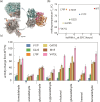High-Throughput Absorbance-Activated Droplet Sorting for Engineering Aldehyde Dehydrogenases
- PMID: 39087463
- PMCID: PMC11586695
- DOI: 10.1002/anie.202409610
High-Throughput Absorbance-Activated Droplet Sorting for Engineering Aldehyde Dehydrogenases
Abstract
Recent decades have seen a dramatic increase in the commercial use of biocatalysts, transitioning from energy-intensive traditional chemistries to more sustainable methods. Current enzyme engineering techniques, such as directed evolution, require the generation and testing of large mutant libraries to identify optimized variants. Unfortunately, conventional screening methods are unable to screen such large libraries in a robust and timely manner. Droplet-based microfluidic systems have emerged as a powerful high-throughput tool for library screening at kilohertz rates. Unfortunately, almost all reported systems are based on fluorescence detection, restricting their use to a limited number of enzyme types that naturally convert fluorogenic substrates or require the use of surrogate substrates. To expand the range of enzymes amenable to evolution using droplet-based microfluidic systems, we present an absorbance-activated droplet sorter that allows droplet sorting at kilohertz rates without the need for optical monitoring of the microfluidic system. To demonstrate the utility of the sorter, we rapidly screen a 105-member aldehyde dehydrogenase library towards D-glyceraldehyde using a NADH mediated coupled assay that generates WST-1 formazan as the colorimetric product. We successfully identify a variant with a 51 % improvement in catalytic efficiency and a significant increase in overall activity across a broad substrate spectrum.
© 2024 The Author(s). Angewandte Chemie International Edition published by Wiley-VCH GmbH.
Conflict of interest statement
The authors declare no conflict of interest.
Figures




References
-
- Olsen M., Iverson B., Georgiou G., Curr. Opin. Biotechnol. 2000, 11, 331–337. - PubMed
-
- Ye L., Yang C., Yu H., Appl. Microbiol. Biotechnol. 2018, 102, 559–567. - PubMed
-
- Alejaldre L., Pelletier J. N., Quaglia D., BioEssays 2021, 43, 2100052. - PubMed
-
- Vasina M., Kovar D., Damborsky J., Ding Y., Yang T., deMello A., Mazurenko S., Stavrakis S., Prokop Z., Biotechnol. Adv. 2023, 66, 108171. - PubMed
MeSH terms
Substances
Grants and funding
LinkOut - more resources
Full Text Sources

